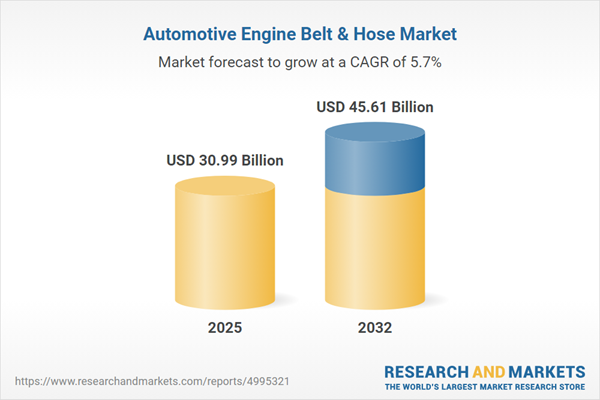Speak directly to the analyst to clarify any post sales queries you may have.
The automotive engine belt and hose market is rapidly evolving, shaped by shifting industry priorities in technology, sustainability, and supply chain optimization. Senior executives seeking data-driven decision support require a holistic assessment of trends, segmentation, and actionable opportunities to inform strategic initiatives.
Market Snapshot: Automotive Engine Belt & Hose Market Overview
The Automotive Engine Belt & Hose Market grew from USD 29.31 billion in 2024 to USD 30.99 billion in 2025. It is expected to continue growing at a CAGR of 5.68%, reaching USD 45.61 billion by 2032. These projections highlight healthy market momentum and signal scalable opportunities for innovation, operational resilience, and investment across both established and emerging markets.
Scope & Segmentation of the Automotive Engine Belt & Hose Market
- Product Types: Serpentine Belt, Timing Belt, V-Ribbed Belt, Air Intake Hose, Coolant Hose, Fuel Hose, Radiator Hose
- Material Types: Composite, Rubber, Thermoplastic Elastomer
- End Users: Aftermarket, Original Equipment Manufacturer
- Distribution Channels: Offline, Online
- Vehicle Types: Commercial Vehicles, Passenger Cars
- Regional Coverage:
- Americas: United States, Canada, Mexico, Brazil, Argentina, Chile, Colombia, Peru
- Europe, Middle East & Africa: United Kingdom, Germany, France, Russia, Italy, Spain, Netherlands, Sweden, Poland, Switzerland, United Arab Emirates, Saudi Arabia, Qatar, Turkey, Israel, South Africa, Nigeria, Egypt, Kenya
- Asia-Pacific: China, India, Japan, Australia, South Korea, Indonesia, Thailand, Malaysia, Singapore, Taiwan
- Featured Companies: Gates Corporation, Dayco Products LLC, Continental AG, Hutchinson SA, Federal-Mogul Motorparts LLC, Bando Chemical Industries Ltd., Sumitomo Riko Company Limited, The Goodyear Tire & Rubber Company, Parker-Hannifin Corporation, Vinko Auto Industries Ltd.
Key Takeaways for Senior Decision-Makers
- Market advancement is supported by rising demands for performance, durability, and compliance, requiring continuous product and material innovation.
- Transition to lightweight thermoplastic elastomers and composite materials is accelerating, challenging traditional manufacturing and supply chain paradigms.
- The infusion of Industry 4.0 technologies, such as real-time monitoring and automated molding, drives efficiency and predictive maintenance capabilities.
- Strategic supplier alliances and agile production methods are enabling faster prototyping, more tailored belt and hose solutions, and faster responses to market changes.
- Regional trends reflect diverse regulatory priorities and infrastructure maturity, shaping product focus from high-durability belts in North America to cost-effective assemblies and digital integration in Asia-Pacific.
- Emergence of digitally enabled sales channels and sophisticated aftermarket segments is expanding opportunities for both established and emerging players.
Tariff Impact: Navigating Cost and Supply Chain Disruption
New U.S. tariff policies in 2025 have prompted a strategic realignment in sourcing, procurement, and regional manufacturing. Key responses include nearshoring, diversifying suppliers within tariff-exempt regions, and updating partnership agreements to incorporate cost adjustments. These measures underscore the importance of risk management and long-term supply chain resilience for OEMs and suppliers in the engine belt and hose industry.
Methodology & Data Sources
This research utilizes a multi-level methodology, integrating in-depth interviews with OEM engineers, procurement leaders, and aftermarket distributors. Secondary research spans trade publications, technical documentation, patent records, and financial disclosures. Data triangulation, scenario modeling, and sensitivity analysis strengthen the reliability of insights and thematic conclusions.
Why This Report Matters to Senior Leaders
- Identifies high-impact growth opportunities and competitive benchmarks in a transforming market environment.
- Delivers segment-specific insights and technology trends to guide investment, partnership, and operational decisions.
- Enables proactive risk mitigation by outlining regional supply chain vulnerabilities and tariff-related adjustments.
Conclusion
The automotive engine belt and hose sector is being reshaped by technology, regulatory shifts, and strategic supply chain decisions. This report offers the evidence-based insights required for sustainable growth and competitive advantage in a dynamic industry landscape.
Additional Product Information:
- Purchase of this report includes 1 year online access with quarterly updates.
- This report can be updated on request. Please contact our Customer Experience team using the Ask a Question widget on our website.
Table of Contents
3. Executive Summary
4. Market Overview
7. Cumulative Impact of Artificial Intelligence 2025
Companies Mentioned
The companies profiled in this Automotive Engine Belt & Hose market report include:- Gates Corporation
- Dayco Products LLC
- Continental AG
- Hutchinson SA
- Federal-Mogul Motorparts LLC
- Bando Chemical Industries, Ltd.
- Sumitomo Riko Company Limited
- The Goodyear Tire & Rubber Company
- Parker-Hannifin Corporation
- Vinko Auto Industries Ltd.
Table Information
| Report Attribute | Details |
|---|---|
| No. of Pages | 184 |
| Published | October 2025 |
| Forecast Period | 2025 - 2032 |
| Estimated Market Value ( USD | $ 30.99 Billion |
| Forecasted Market Value ( USD | $ 45.61 Billion |
| Compound Annual Growth Rate | 5.6% |
| Regions Covered | Global |
| No. of Companies Mentioned | 11 |









